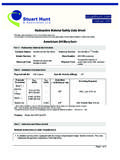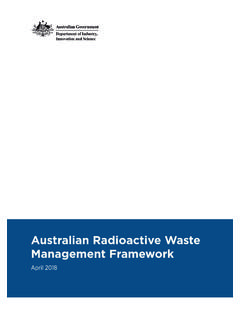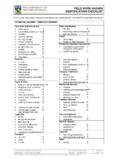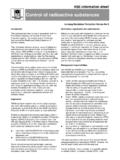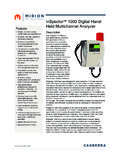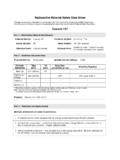Transcription of Radioactive Material Safety Data Sheet Cobalt-60
1 Radioactive Material Safety data Sheet : Cobalt-60 Page 1 of 3 Radioactive Material Safety data Sheet This data Sheet presents information on radioisotopes only. For information on chemical compounds incorporating this radionuclide, see the relevant Material Safety data Sheet . Cobalt-60 Part 1 Radioactive Material Identification Common Names: Cobalt-60 Chemical Symbol: Co-60 or 60Co Atomic Number: 27 Mass Number: 60 (33 neutrons) Chemical Form: Cobalt metal Physical Form: Thin cylinder or foil of cobalt metal Part 2 Radiation Characteristics Physical half-life: years Specific Activity (GBq/g): 41,800 Principle Emissions EMax (keV) Eeff (keV) Dose Rate ( Sv/h/GBq at 1m) Shielding Required Beta* ( ) 318 (100%) 96 - - Gamma ( ) / X-Rays 1173 (100%) 1332 (100%) - 370a HVL Lead: cm Alpha ( ) - - - - Neutron (n) - - - - Where Beta radiation is present, Bremsstrahlung radiation will be produced.
2 Shielding may be required. Note: Only emissions with abundance greater than 10% are shown. a Handbook of Health Physics and Radiological Health, Lippincott Williams & Wilkins , Third Edition, 1998 Progeny: Nickel-60 (Ni-60) Part 3 Detection and Measurement Methods of detection (in order of preference) 1. A radiation survey meter equipped with an energy-compensated Geiger Mueller detector. 2. Ion chamber survey meter tends to be less sensitive than a Geiger Mueller survey meter but is able to respond more precisely in higher radiation fields. Radioactive Material Safety data Sheet : Cobalt-60 Page 2 of 3 3. Gamma scintillation detector very sensitive but is also energy dependent. Must be calibrated for Co-60 before it can be used for dose assessment surveys.
3 Dosimetry Whole Body Skin Extremity Neutron Internal: Sealed sources pose no internal radiation hazard. However, in the event of loss of containment by the sealed source, all precautions should be taken to prevent inhalation or ingestion of the Material . Critical Organ(s): Liver and whole body Annual dose limits: Non-nuclear energy workers: 1mSv per year Nuclear energy workers: a) 50 mSv in one year b) 100 mSv total over five years Pregnant nuclear energy workers: 4 mSv over the balance of the pregnancy Part 4 Preventive Measures Always use the principles of time, distance and shielding to minimize dose Engineering Controls: Sealed Radioactive sources used in industrial applications should always be within a protective source housing to minimize radiation dose and to protect the source capsule from damage.
4 Personal Protective Equipment (for normal handling of unsealed sources only. Always wear disposable gloves, Safety glasses, personal protective equipment and clothing as appropriate to the Material handled). No special PPE required. Special Storage Requirements: None Part 5 Control Levels Oral Ingestion Inhalation ALI (kBq) ALI (kBq) DAC (Bq/ml) 18,500 7,400 x 10-3 Exemption Quantity (EQ): 100,000 Bq Radioactive Material Safety data Sheet : Cobalt-60 Page 3 of 3 Part 6 Non-Radiological Hazards Prolonged exposure to airborne particles mat result in coughing, dyspnea, decreased pulmonary functioning and respiratory hypersensitivity. Confirmed animal carcinogen with unknown relevance to humans. OSHA Permissible Exposure Limit (PEL): mg/m3 Part 7 - Emergency Procedures The following is a guide for first responders.
5 The following actions, including remediation, should be carried out by qualified individuals. In cases where life-threatening injury has resulted, first treat the injury, second deal with personal decontamination. Personal Decontamination Techniques Wash well with soap and water and monitor skin Do not abrade skin, only blot dry Decontamination of clothing and surfaces are covered under operating and emergency procedures Spill and Leak Control Alert everyone in the area Confine the problem or emergency (includes the use of absorbent Material ) Clear area Summon Aid Damage to Sealed Radioactive Source Holder Evacuate the immediate vicinity around the source holder Place a barrier at a safe distance from the source holder (min.)
6 5 meters) Identify area as a radiation hazard Contact emergency number posted on local warning sign Suggested Emergency Protective Equipment Gloves Footwear Covers Safety Glasses Outer layer or easily removed protective clothing (as situation requires to minimize contamination) This information was prepared by: Stuart Hunt & Associates Ltd. 15803 - 145 Avenue , Alberta T6V 0H8 Phone: (780) 458-0291 or (800) 661-4591 Fax: (905)-602-0774 Website.

